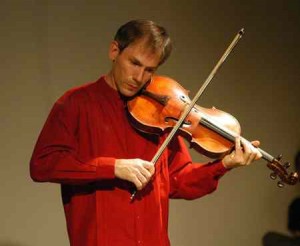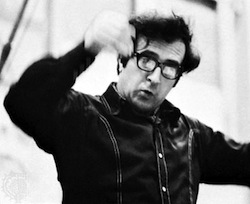Most of tonight’s choices come as a result of talking to an old friend from Berkeley. We were discussing early music in particular and some of the ‘obsolete’ instruments that would be nice if they weren’t so obsolete. Viola da Gamba was one of the them (which I played for a few years at UW during grad school, and would love to get back into again) as well as the Baryton and Viola d’Amore. These last two are string instruments (similar to cello and viola, respectively) that feature a second set of strings that are strung through the neck and below the regular strings. These are usually tuned to a specific scale and are then allowed to resonate in sympathy with whatever is being played – creating a stringy, halo-ish reverb. Haydn wrote a huge number of pieces for Baryton trio (that have been recorded a couple times). But just as rare is the Viola d’Amore (though, since I have helped out Garth Knox with a few concerts I have actually seen and heard this instrument a number of times).
Garth has been touring and gathering new works for Viola d’Amore for a number of years now, and I have also worked with him on a project to re-do the electronics for Grisey’s ‘Prelude’ for viola and resonators. Sympathetic vibration (and spectral modeling) has been a fascination of mine for a number of years now, going back to my ‘Music for Bassoon’ that has a VERY crude model of a resonating piano as its basis. But since that piece (over the past 6 years or so) I have been working on different ways to make it sound as though one instrument is playing through another. Working on the Grisey piece actually brought me close to doing what I wanted, but it wasn’t until I was working on the electronics for my viola piece ‘Theta‘ where I was able to get something to work that would take a snapshot from a performer in real-time and then let that player make it resonate. Hearing Garth play pieces on the Viola d’Amore was really the inspiration for this, and I spent a better part of a year coming up with algorithms that allowed me to do this, and I think the sonic result is quite convincing.
However – I’m not saying that I think my stuff sounds like Viola d’Amore. The sound of this instrument is beautiful and his playing on his disc ‘D’Amore’ is wonderful. There are some older pieces on the disc (a Marais piece, some traditional tunes as well as a set of variations by Garth Knox on ‘Malor Me Bat’), but there are also a couple of modern pieces that take advantage of the idiosyncrasies of the instrument. Of particular note is Klaus Huber’s ‘…Plainte…’ which is an elegy to another favorite composer of mine Luigi Nono. The microtones slide around leaving halos behind them when they come into tune with the sympathetic strings in a delicate way.
I also ripped Garth’s ‘Spectral Viola’ disc (with Grisey, Murail, Scelsi and Radulescu) and his solo debut disc on naïve (with the Berio Sequenza for solo viola and Sciarrino’s ‘Tre notturno brillante’). The Sciarrino may be one of my favorite late 20th century pieces… and I am not ashamed to say that I grabbed a number of tricks from the score for these works for ‘Theta’.



